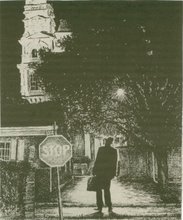 (Gloucester painting by Theodoros Stamos)
(Gloucester painting by Theodoros Stamos)
Gloucester is a city of hills, marvelous and steep, as I knew from my tired legs, walking endlessly up and down them as a child with my grandfather, Angel Polisson. But the views from Governor’s Hill or the summit of Ledgmont Avenue, to name but a few of our many vantage points, are also stupendous, rewarding any effort to discover them.
From first grade I walked over Rider’s Rocks, between Centennial Avenue and Hovey Street, as a short cut to the Hovey School. From that granite outcropping you could look across Newell Stadium to the Essex Avenue marshes and all the way up behind the high school to Done Fudgin’. Once you reached Hovey Street, at Roger Babson’s house with its distinctive red turret, you could see almost to Boston. On a clear night the lights of Cape Cod dotted the horizon.
Don’t think that because we were young we didn’t want to observe the world from any height or angle available to us. There were no distracting TVs in the 1940s. And radio, while it may have kindled our imaginations—who wouldn’t have been excited by The Shadow?—didn’t Disneyfy our perceptions. No, we were noticers, we kids who lived down the Cut, on Babson Court or along Mansfield Street. From the Boulevard we watched the endless stream of fishing vessels and pleasure boats as they negotiated the Blynman Canal. We were curious also to see the tourists, who began to stream back into the city after the war, the women in flamboyant straw hats and the men in plaid shorts, which no native would appear dead in on Main Street if you wanted to avoid that quintessential expression of Gloucester derision: “Down for the summah?”
But it’s the hills I’ve had on my mind ever since I recently walked up to Governor’s Park. Dusk was approaching, that magical hush as the day ends and the night has not quite declared itself. I stood listening to the muted sounds of the city—the voices of kids playing after supper, the barking of dogs, the muffled roar of automobile engines. Robins sang, swallows darted in the muggy air. And beneath me the city spread out from East Gloucester and the Paint Factory to Ravenswood.
Where else would one ever want to be? What else would one want to do on such a summer night but stand and take it all in? There was the familiar roof of the Hovey School, now condos, the assorted 19th and 20th century houses of Beacon Hill, just below Commonweath Avenue where I stood, and the harbor itself, spotted with small craft heading for their moorings as night began to fall.
It was here on Governor’s Hill, in the big Victorian house to the right as you face the park, that I was taken one Sunday morning during the war by our neighbor Gardner Deering. Gardner was an air-raid warden, and at the top of that house, in its attic or under an enclosed widow’s walk, was a lookout station. Surrounded by windows, the men who were on duty there, Coast Guardsmen or Civil Defense volunteers like Gardner, watched for signs of strange aircraft or German submarines. I remember maps strewn about and a short-wave radio. I couldn’t have been more than six or seven years old, when I climbed the dark, echoing stairway to the top of the house; but I’ve never forgotten the view out across the city and the harbor. I remember the men, patiently explaining to me what their mission was, for German subs had been sighted off Thacher’s Light and the Isle of Shoals, and I later learned that spies, speaking perfect English, had come ashore in South Portland, where they were apprehended by the Coast Guard.
So hills served a wartime purpose, as did the concrete watchtowers on Eastern and Halibut points. But as children I think it was more the wonder of heights that drew us, as we envied the people whose houses commanded such a view through all the seasons. I remember following a narrow wooded path at Ravenswood Park with my friend Bob Stephenson, only to emerge at the top of a ridge from which the city itself, from City Hall to Eastern Point Light, unfolded magically beneath us.
And what about Fiesta from Governor’s Hill or the top of Ledgmont, high above the blue carillon towers of Our Lady of Good Voyage? You may not be able to see the crowds or smell the sizzling peppers and sausages, the fried dough; but you can hear the vibrant music of the Italian bands and the voices of the revelers as if you were looking down on it all from the heights of Palermo. But make no mistake, it’s Gloucester, and we had better love it or lose it



No comments:
Post a Comment